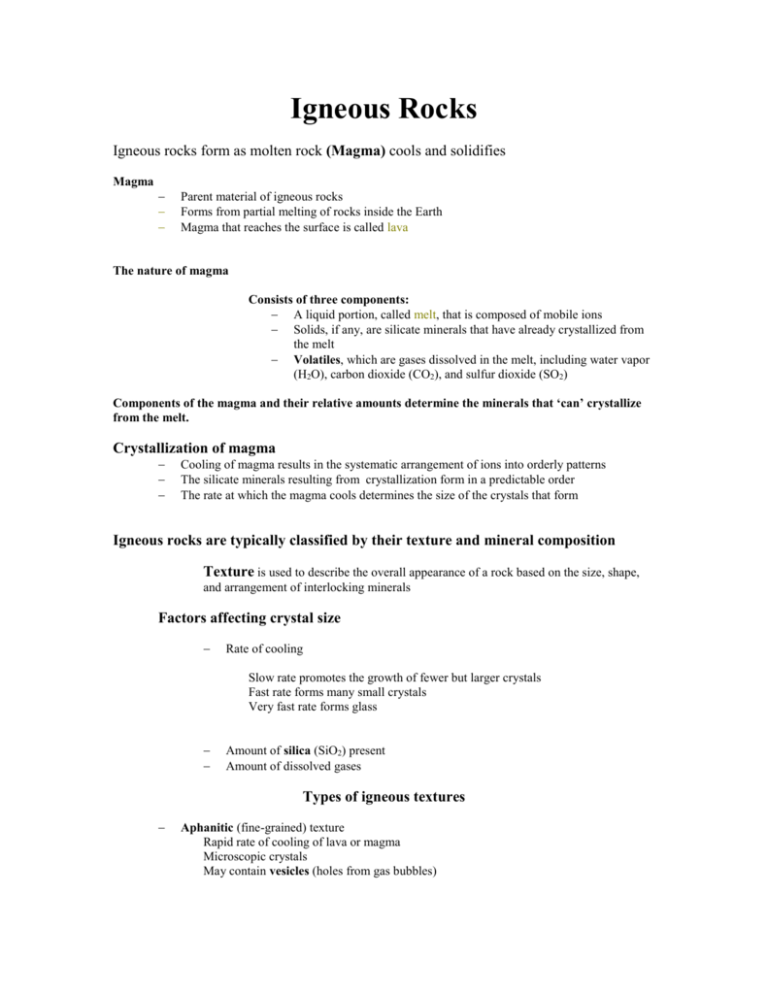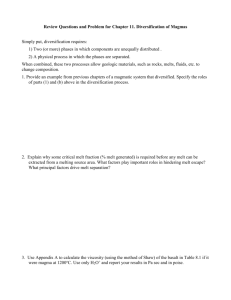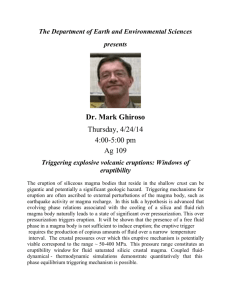Igneous rocks form as molten rock (Magma) cools
advertisement

Igneous Rocks Igneous rocks form as molten rock (Magma) cools and solidifies Magma Parent material of igneous rocks Forms from partial melting of rocks inside the Earth Magma that reaches the surface is called lava The nature of magma Consists of three components: A liquid portion, called melt, that is composed of mobile ions Solids, if any, are silicate minerals that have already crystallized from the melt Volatiles, which are gases dissolved in the melt, including water vapor (H2O), carbon dioxide (CO2), and sulfur dioxide (SO2) Components of the magma and their relative amounts determine the minerals that ‘can’ crystallize from the melt. Crystallization of magma Cooling of magma results in the systematic arrangement of ions into orderly patterns The silicate minerals resulting from crystallization form in a predictable order The rate at which the magma cools determines the size of the crystals that form Igneous rocks are typically classified by their texture and mineral composition Texture is used to describe the overall appearance of a rock based on the size, shape, and arrangement of interlocking minerals Factors affecting crystal size Rate of cooling Slow rate promotes the growth of fewer but larger crystals Fast rate forms many small crystals Very fast rate forms glass Amount of silica (SiO2) present Amount of dissolved gases Types of igneous textures Aphanitic (fine-grained) texture Rapid rate of cooling of lava or magma Microscopic crystals May contain vesicles (holes from gas bubbles) Phaneritic (coarse-grained) texture Slow cooling Crystals can be identified without a microscope Porphyritic texture Minerals form at different temperatures as well as differing rates Large crystals, called phenocrysts, are embedded in a matrix of smaller crystals, called the groundmass Glassy texture Very rapid cooling of molten rock Resulting rock is called obsidian Pyroclastic texture Various fragments ejected during a violent volcanic eruption Textures often appear to more similar to sedimentary rocks Pegmatitic texture Exceptionally coarse grained Form in late stages of crystallization of granitic magmas Mineral Composition Igneous rocks are composed primarily of silicate minerals Dark (or ferromagnesian) silicates Olivine Pyroxene Amphibole Biotite mica Light (or nonferromagnesian) silicates Quartz Muscovite mica Feldspars Granitic versus basaltic compositions Granitic composition Designated as being felsic (feldspar and silica) in composition Composed of light-colored silicates Contains high amounts of silica (SiO2) Major constituents of continental crust Basaltic composition Composed of dark silicates and calcium-rich feldspar Designated as being mafic (magnesium and ferrum, for iron) in composition More dense than granitic rocks Comprise the ocean floor as well as many volcanic islands Other compositional groups Intermediate (or andesitic) composition Contain at least 25 percent dark silicate minerals Associated with explosive volcanic activity Ultramafic composition Rare composition that is high in magnesium and iron Composed entirely of ferromagnesian silicates Silica content as an indicator of composition Silica content in crustal rocks exhibits a considerable range A low of 45 % in ultramafic rocks Over 70 % in felsic rocks Affect of silica content on magma Granitic magma High silica content Extremely viscous Liquid exists at temperatures as low as 700 oC Basaltic magma Much lower silica content Fluid-like behavior Crystallizes at higher temperatures Origin of Magma *Highly debated topic Generating magma from solid rock Produced from partial melting of rocks in the crust and upper mantle Role of heat: Temperature increases within Earth’s upper crust (called the geothermal gradient) average between 20oC to 30oC per kilometer Estimated temperatures in the Crust and Mantle Rocks in the lower crust and upper mantle are near their melting points Any additional heat (from rocks descending into the mantle or rising heat from the mantle) may induce melting Role of pressure An increase in confining pressure causes an increase in a rock’s melting temperature or conversely, reducing the pressure lowers the melting temperature When confining pressures drop, decompression melting occurs Role of volatiles Volatiles (primarily water) cause rocks to melt at lower temperatures This is particularly important where oceanic lithosphere descends into the mantle Evolution of Magma A single volcano may extrude lavas exhibiting very different compositions N.L. Bowen demonstrated that as a magma cools, minerals crystallize in a systematic fashion based on their melting points During crystallization, the composition of the liquid portion of the magma continually changes Composition changes due to removal of elements by earlier-forming minerals The silica component of the melt becomes enriched as crystallization proceeds Minerals in the melt can chemically react and change Processes responsible for changing a magma’s composition Magmatic differentiation Separation of a melt from earlier formed crystals to form a different composition of magma Assimilation Changing a magma’s composition by the incorporation of foreign matter (surrounding rock bodies) into a magma Magma mixing Involves two bodies of magma intruding one another Two chemically distinct magmas may produce a composition quite different from either original magma Partial melting and magma formation Incomplete melting of rocks is known as partial melting Formation of basaltic magmas Most originate from partial melting of ultramafic rock in the mantle Basaltic magmas form at mid-ocean ridges by decompression melting or at subduction zones As basaltic magmas migrate upward, confining pressure decreases which reduces the melting temperature Large outpourings of basaltic magma are common at Earth’s surface Formation of andesitic magmas Interactions between mantle-derived basaltic magmas and more silica-rich rocks in the crust generate magma of andesitic composition Andesitic magma may also evolve by magmatic differentiation Formation of granitic magmas Most likely form as the end product of crystallization of andesitic magma Granitic magmas are higher in silica and therefore more viscous than other magmas Because of their viscosity, they lose their mobility before reaching the surface Tend to produce large plutonic structures






